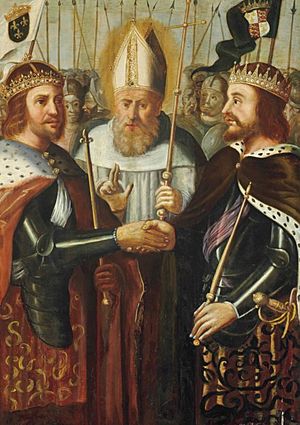Treaty of Picquigny facts for kids
The Treaty of Picquigny was an important peace agreement. It was signed on August 29, 1475. This treaty brought peace between the Kingdom of England and the Kingdom of France. It happened after England's King Edward IV invaded France. He had help from allies like Burgundy and Brittany. The treaty allowed France's King Louis XI to deal with his own problems, especially with Charles the Bold, the Duke of Burgundy.
Contents
Why the Treaty Was Needed
Before this treaty, England and France had been fighting for a long time. King Edward IV of England wanted to claim the French throne. In 1474, he made a deal with Charles the Bold, the Duke of Burgundy. Charles promised to help Edward invade France.
In June 1475, Edward IV landed in France with a large army. He had about 11,000 soldiers and 2,000 archers from Brittany. Edward planned to march through Burgundy to a city called Reims.
However, Charles the Bold did not keep his promise. He did not give Edward the help he needed. Charles even stopped the English army from entering towns he controlled. Edward also got little support from his other ally, Francis II, Duke of Brittany.
King Louis XI of France saw this as a chance. He sent a message to Edward. Louis offered Edward a better deal than his allies had. He convinced Edward to meet and talk about peace.
The Meeting at Picquigny
The two kings, Edward IV and Louis XI, met near a town called Picquigny. This was just outside Amiens. They met on a special bridge built just for this meeting. The bridge had a wooden barrier in the middle. This barrier kept the kings and their groups separate. This meeting led to the signing of the treaty.
What the Treaty Decided
The agreement was signed on August 29, 1475. It included several important points:
- Seven-Year Truce: Both kings agreed to stop fighting for seven years.
- Free Trade: People could trade goods freely between England and France.
- Payments to England: Louis XI agreed to pay Edward IV a large sum of money. He paid 75,000 crowns right away. This was like a payment for Edward to go back to England. Edward also got 50,000 crowns every year after that.
- Ransom for Queen Margaret: The King of France also paid 50,000 crowns to free Margaret of Anjou. She was the former English queen and was being held by Edward.
- Pensions for English Lords: Many of Edward's important lords also received money from the French king. For example, William Hastings, 1st Baron Hastings, who helped make the treaty, received 2,000 crowns a year.
Other Agreements
The treaty also had other rules:
- Help Against Rebellions: If either king faced a rebellion, the other king would send military help.
- Royal Marriage: Edward's daughter, Elizabeth of York, was to marry the French prince, Charles, when she was old enough.
- Future Discussions: Any disagreements between the kings, including England's claim to the French throne, would be discussed. A committee would meet every year to talk about these issues. Their decisions would be final.
How People Felt About the Treaty
A writer named Philippe de Commines wrote about these negotiations. He said that the Duke of Gloucester, who later became King Richard III, did not like the treaty. He thought it was dishonorable. He refused to be part of the talks. However, he did join the celebrations afterward.
Some people in both England and France thought the treaty was not honorable. They felt that the payments made it seem like a bribe. For example, an English envoy in Spain said that this deal took away the honor from all of Edward's past military wins.


